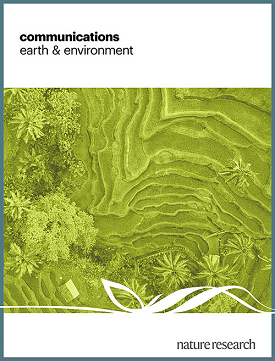Weakening of subsurface ocean temperature seasonality over the past four decades
IF 8.9
1区 地球科学
Q1 ENVIRONMENTAL SCIENCES
引用次数: 0
Abstract
The seasonal cycle, responsible for much of the temperature variability in the upper ocean, exerts profound climatic and ecological influence. While surface intensification of temperature seasonality has been widely examined, changes beneath the ocean surface remain unknown. Here we analyze multiple ocean temperature datasets, revealing a robust, substantial weakening of subsurface seasonality by 5.7 ± 1.8% below the mixed layer in extratropical oceans since the 1980s. Using a hierarchy of climate models and an idealized diffusive model, we attribute this weakening to increased ocean heat uptake driven by rising greenhouse gases. This process strengthens upper ocean stratification, suppresses vertical mixing, and limits heat penetration into deeper ocean layers, resulting in a more quiescent subsurface ocean with reduced seasonal variability. Our findings highlight a new fingerprint of anthropogenic influence on subsurface ocean seasonality, with important implications for ocean biogeochemical processes and marine ecosystems. Since the 1980s, subsurface temperature seasonality in extratropical oceans has decreased by 5.7 ± 1.8% below the mixed layer due to increased heat uptake from greenhouse gases, strengthening upper ocean stratification, and limiting heat penetration into deeper layers, according to analysis of a hierarchy of climate models and an idealized diffusive model.

过去40年海底温度季节性的减弱
造成海洋上层温度变化的主要原因是季节循环,它对气候和生态有着深远的影响。虽然已经广泛研究了表面温度季节性的增强,但海洋表面下的变化仍然未知。在此,我们分析了多个海洋温度数据集,发现自20世纪80年代以来,温带海洋混合层以下的次地表季节性明显减弱了5.7±1.8%。利用气候模式层次和理想扩散模式,我们将这种减弱归因于温室气体增加导致的海洋热吸收增加。这一过程加强了上层海洋的分层,抑制了垂直混合,并限制了热渗透到更深的海洋层,导致一个更平静的地下海洋,减少了季节变化。我们的发现突出了人类活动对海洋地下季节性影响的新指纹,对海洋生物地球化学过程和海洋生态系统具有重要意义。根据气候模式层次和理想扩散模式的分析,自20世纪80年代以来,混合层以下温带海洋的次表层温度季节性下降了5.7±1.8%,这是由于温室气体的热量吸收增加、上层海洋分层加强以及热量渗透到较深层的限制。
本文章由计算机程序翻译,如有差异,请以英文原文为准。
求助全文
约1分钟内获得全文
求助全文
来源期刊

Communications Earth & Environment
Earth and Planetary Sciences-General Earth and Planetary Sciences
CiteScore
8.60
自引率
2.50%
发文量
269
审稿时长
26 weeks
期刊介绍:
Communications Earth & Environment is an open access journal from Nature Portfolio publishing high-quality research, reviews and commentary in all areas of the Earth, environmental and planetary sciences. Research papers published by the journal represent significant advances that bring new insight to a specialized area in Earth science, planetary science or environmental science.
Communications Earth & Environment has a 2-year impact factor of 7.9 (2022 Journal Citation Reports®). Articles published in the journal in 2022 were downloaded 1,412,858 times. Median time from submission to the first editorial decision is 8 days.
 求助内容:
求助内容: 应助结果提醒方式:
应助结果提醒方式:


